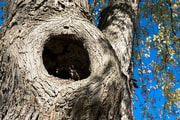Bizarre images caught by Google Maps are almost too hard to believe they’re real
- Replies 6
Google Maps is a web mapping platform offered by Google, which allows users to take a look at satellite imagery, aerial photography, street maps, and even 360° interactive panoramic views of streets. It is also used to track real-time traffic conditions and plan routes when travelling by foot, car, or public transportation.
The online platform was co-invented by Australian software engineer, Noel Gordon.
Since it was launched in 2005, it has taken millions of satellite and aerial photos that have all been stitched together to create Google Earth observation data.
But not all gathered information is ordinary. Hidden among the millions of Google images are some weird, incredible, and downright unexplainable photos.
So, here is a list of some of the coolest and strangest Google images that have been found:
Mysterious ‘pyramids’
Photo credit: Google Earth via Live Science.
In the past five years, dozens of anomalies in Egypt have been detected using Google Earth. However, it is still unknown whether they’re natural or artificial structures.
Desert Breath
Photo credit: Google Earth via Live Science.
Though it looks like an ‘alien message’ or an ‘ancient monument’, it is actually an art installation called Desert Breath, made by Greek artists Danae Stratou, Alexandra Stratou, and Stella Constantinides in March 2007.
The million square foot (100,000 square meters) artwork was meant to celebrate "the desert as a state of mind, a landscape of the mind.”
Kazakhstan Pentagram
Photo credit: Google Maps via Live Science.
For years it’s been linked with occult movements, with many online comments saying it was used for devil worship, nefarious religious sects, or denizens of the underworld.
However, it turned out the pentagram is the outline of a park made in the form of a star, marked by roadways that are now lined with trees.
The ‘boneyard’Photo credit: Google via Live Science.
The 2,600-acre cemetery of steel is closed to the general public. Still, Google Earth provides a high-resolution glimpse of what's inside: virtually every plane the military has flown since World War II in various stages of decay.
Vulcan’s Throne
Photo credit: Google Earth via Live Science.
The pattern is observed to be due to the movements of red harvester ants, pesky critters that can create nesting mounds spanning some 47 inches (120 centimetres) across and are typically surrounded by bare ground up to 108 square feet (10 square meters).
Gobi desert
Photo credit: Google Earth via Live Science.
The intricate grid of perfectly straight lines that weave back and forth is most likely a Yagi antenna array, a device used for weather tracking and other atmospheric research.
However, experts believe that this is a secret military base, and the structures are used for a variety of purposes, including weapons testing, spy satellite calibration, and testing of radar instrumentation.
Sudanese ‘lips’
Photo credit: Google via Live Science.
Phantom island
Photo credit: Google via Live Science.
The island was believed to be 24 kilometres long and five kilometres wide. It had popped up on various maps and even showed up as a black polygon-shaped island on Google Earth. But when scientists sailed there in November 2012, they found open water instead of solid ground.
You won’t find it on Google Maps today. Instead, it was replaced by a faint outline of what looks like a long, thin island with no landmass in sight.
Blood-red lake
Photo credit: Google via Live Science.
So far, there has been no official explanation for the mysterious phenomenon.
Atacama Giant
Photo from news.com.au.
Dubbed as the ‘Atacama Giant’, the figure was used as an early astronomical calendar for determining the day, season, and crop cycle.
Australian ‘UFO’
Photo credit: Google via Live Science.
The “UFO” was first discovered in 2007 and was believed to have been caught hovering above the Earth.
However, other Google Earth users said it might be a signal tower from a nearby remote-controlled wind farm.
Kazakhstan ‘swastika’ symbol
Photo credit: Google via Live Science.
The geoglyphs seemed to date back 2,000 years and were believed to have been built at the beginning of Kazakhstan’s Iron Age.
At the time, swastikas were not uncommon across Europe and Asia and were not affiliated with any political beliefs.
Azraq Oasis wheels
Photo credit: Google Earth via Live Science.
The wheels vary in their design, with some showing spokes that radiate from the centre, others with just one or two bars rather than spokes. Some seemed to be positioned in a way that aligns with sunrise on the winter solstice.
Island in a lake, on an island in a lake, on an island
Photo credit: Google Earth via Live Science.
It is located within the island of Luzon, on Volcano Island, which has Crater Lake, which contains its own small island called Vulcan Point.
For years, this phenomenon was thought to be the largest of its kind, as seen on Google Earth. However, the world's largest "island, in a lake, on an island, in a lake, on an island" is a four-acre strip of land in Canada. No human has ever actually set foot there.
HAMAD
Photo credit: Google Earth via Live Science.
The letters HAMAD may be the world’s largest at half a mile tall and 2 miles long altogether. They’re even visible from space!






